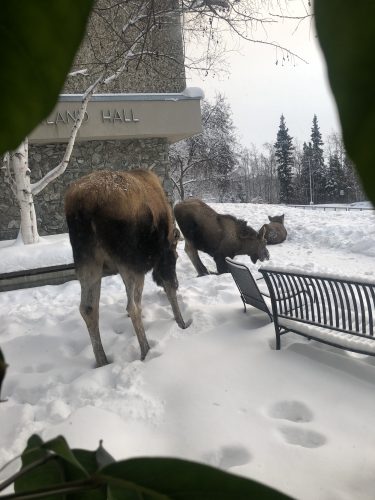Be moose-aware
December 5, 2019

Moose are a routine part of life for many Alaskans and are frequent visitors on UAF campuses, especially in winter. Be sure to look around you when you leave a building or walk along roads and paths, even ones that are frequently traveled by other people.
So what do you do when you see a moose?
- Give them lots of room — at least 50 feet, more if you believe a calf may be nearby.
- Moose generally will move out of an area when they notice you. If the moose doesn’t yield as you approach, retreat and leave the area immediately.
- Moose can be easily frightened and have been known to charge without notice. If a moose lays its ears back or raises its hackles (the hairs on its hump), it’s a sign that it is angry or afraid and may charge.
- If a moose charges, get behind a tree. You can run around the trunk faster than the moose can.
- Moose kick with their front as well as hind feet.
- Never attempt to feed or approach a moose; do not corner moose in fences or buildings.
- Never get between a cow and her calf.
If you think the moose presents a danger to people, please call the UAF Police Department at 474-7721. The police will determine if it is safe to use emergency vehicles with sirens and lights to encourage the moose to move to less-populated areas. Sometimes it is safer to just follow the moose and keep people away than to startle the animal into running in an uncertain direction.
Motorists should also watch for moose and use caution while on campus.


